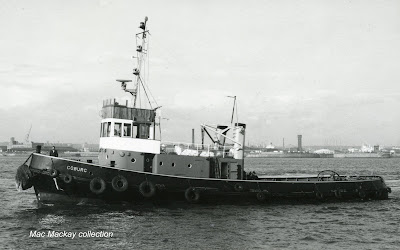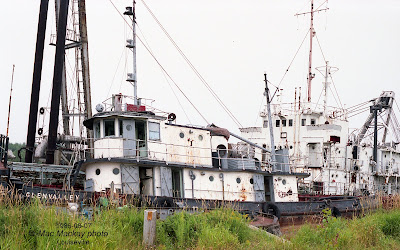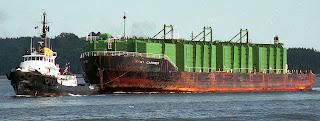![]()
1. Typical Glens harbour tugs of the RCN. Note the huge rope puddings on the bows.
During World War II the Royal Canadian Navy’s need for tugs increased dramatically, and several classes of tugs were built. One of these was the
Glen class of which sixteen steel hull and three wooden hull tugs were built between 1943 and 1944. A fourth wooden hull and at least one steel hull were cancelled before completion. Used for harbour work, they were about 100 gross tons, 85 feet long and fitted with 300 bhp or 400 bhp engines, giving a bollard pull of 4.5 tons.
Many of these tugs survive today. At nearly 70 years old, they are remarkable examples of longevity. To my knowledge only one of the steel hull tugs was actually broken up for scrap. One was lost, one was sunk intentionally and five others are unaccounted for- they ended up somewhere in the Caribbean, and are untraceable. But four are still working in Canadian waters. All three wood tugs are also still in existence, on the west coast.
Russel Brothers of Owen Sound built eleven of the steel tugs and Kingston Shipyard built five.
At the end of World War II most were sold off by the navy, but they kept five on the east coast and the three wooden ones on the west coast. Four tugs were transferred to other government agencies.
Of the five tugs the navy kept on this coast, four were sold after new
Glen class tugs were delivered in 1977-78, and one was sunk for a dive site.
Glendyne, which had girted and sank in 1957 was raised and rebuilt. It sank while berthing HMCS
Magnificent and two lives were lost in the incident. It was sunk in Wreck Cove, in Eastern Passage as a navy dive training site in 1979. One of the Navy's 1977
Glen class tugs, based on the west coast was given the name
Glendyne in remembrance of this incident.)
Of the early sales to civilian owners were
Gleneagle (built in Kingston) and
Glenlea. Both went to Maritime Towing and Salvage (Foundation Martime) and were renamed
Bansturdy and
Bansaga respectively. They were used for harbour work in Halifax in the winter, and in summer they worked the Saguenay River and Baie Comeau area until new tugs arrived in the early sixties. According to Foundation Maritime literature,
Bansaga was re-powered to 600 bhp.
Both were then acquired by Gravel and Lake Service of Thunder Bay, ON, where they still soldier on as
Robert John and
George N. Carleton.2. Based in the fresh water of Thunder Bay, this pair should last forever.
Robert John was repowered in 1973 and now boasts 1250 bhp. It also has a new wheelhouse.
George N. Carleton was also repowered to 1250 bhp, but retains an original appearance, except for a modified funnel. As built all were fitted with an after mast and derrick for handling a lifeboat. When liferafts were permitted instead, most had the derrick removed.
Shortly after the war the RCN tugs were decommissioned as naval vessels, and assigned to the auxiliary fleet, and manned by civilians, under the control of the Queen’s Harbour Master. In 1956 the navy loaned
Glenlivet II (so named because another tug already carried the name
Glenlivet) to the Department of Public Works, where it was used for survey and dredging work. DPW installed a new steel bridge structure before returning the tug in 1970. The
Glens that remained in the Dockyard, had their captain's cabins removed and wheelhouses (made of wood) were set back to provide more clearance while working close in to navy ships.
3. Glenlivet's larger wheelhouse was needed to accommodate survey crews, but was unsuitable for close in harbour work. The other Glens had only small wheelhouses, set back on the deck house.
In 1977
Glenlivet II was sold becoming the pleasure craft Canadian Franko until 1982 when it was acquired by McKeil Workoats of Hamilton, ON and it reverted to
Glenlivet II. They sold it in 1989 to Construction Dufresne of Montreal, then it went to Voyageurs Marine Construction in 1990.
4. Glenlivet II back in Halifax to tow out a dredge-still painted in yacht-like colours.
In 2000 Nadro Marine Services of Port Dover purchased it and renamed it
Vigilant I. They still operate it now, and have removed the bridge “wings” making the wheelhouse and captains cabin the same width.Since it works in the Welland Canal and Seaway Locks much of the time, the wide bridge was a real liability.
McKeil Workboats acquired the three remaining navy
Glens:
Glenbrook,
Glenevis and
Glenside in 1979, keeping the original names, but modifying the tugs over time with new wheelhouses and propulsion modifications.(When the navy took delivery of its new
Glen tractor tugs, they re-used these three names for the Halifax based tugs.)
5. Glenevis still in RCN configuraiton. It was later modified with a new wheelhouse and captain's cabin.
6. Glenbrook got a new extended wheelhouse, placed farther forward.
7. Glenside had a new wheelhouse and captain's cabin added during its McKeil tenure.
Glenside was sold in 1998,
Glenbrook in 1999 and
Glenevis in 2007. All headed south via the Erie Canal, and I have not been able to trace their movements after leaving Long Island, NY.
A fourth
Glen,The Paul E. No.1 ex
E.A.Rockett (New Brunswick International Paper Co 1947-75) ex
WAC. 4 (War Assets Corp 1945-46) had also been picked up by McKeil after working for Allied Tug and Barge in Windsor ON (they renamed it
The Paul E. No.1) and Lebrun Contracting of Thunder Bay (1980-90). It also received a new wheelhouse, and was sold south in 2007.
Glenada saw service with the National Harbours Board in Montreal then the St.Lawrence Seaway Authority and the Minister of Transport.Sandrin Brothers of Sarnia, ON acquired the tug in 1973 and gave it a major rebuild with a new engine of 1125 bhp, new wheelhouse and sponsoned the hull. It was sold to Thunder Bay Tug Services in 1995 and still works at the Lakehead as a harbour tug.
8. Glenada, tucked in behind fleet mate Point Valour, is one of three Glens based in Thunder Bay, but is barely recognizeable as such after a major rebuild in the 1970s.
Glenkeen (built in Kingston) operated for the National Harbours Board in Montreal until 1979 and was sold unmodified to Maritime Shipping Ltd of Halifax. They found work for it in the Caribbean, and it sailed to Grenada in 1980 where it worked for a couple of years, but I have not heard of it since.
9. Glenkeen looked pretty much the same as when she was built, losing only an after mast/derrick for a lifeboat.
Glenmont operated for the Newfoundland Minister of Public Works until 1969 when it went to the National Harbours Board in St.John’s. Toronto owners bought the tug in 1988 and it spent more than a decade undergoing various conversions, until it was finally completed in 2002 as the pleasure craft Carolina Borealis. So little was left of the original that it was re-registered as a new vessel.
10. Glenmont worked in St.John's harbour for most of its life, and was always kept in pristine condition.
Glenvalley went to Marine Industries Ltd of Sorel in 1946 and operated for them and their dredging subsidiary Dragage Richelieu until 1976 when it was sold for scrap to P-E Caron of Louiseville, QC. Plans to use it as a dive site fell through and it was finally cut up in 1996.
11. Glenvalley is the only Glen actually confirmed to have been scrapped (although there are five whose whereabouts are unknown). It is shown here with the remains of the Dragage Richelieu fleet at the scrapyard in Louiseville, QC, where it languished for many years before actually being broken up.
Of the other steel tugs,
Glencove and
Glenora went to the west coast where they are still working as
Glen Rover and
Glenshiel. (more on them, and the wooden hulls another time.)
Glenella (Kingston built) after working for Maritime Towing and Salvage as
Banswift was sold to Canada Steamship Lines in 1962 and operated as
Bayport in Georgian Bay until sold in 1973. After a main engine failure it was laid up and its registration suspended in 2008, when it was removed from the water and converted to playground structure in Hamilton, ON.
Glenfield (Kingston built) left navy service in 1946 and was bought by J.D.Irving Ltd. On April 8, 1957 it sailed from Liverpool, NS for Saint John. NB and went missing with five crew. Some flotsam was recovered, but there has never been an explanation for its sinking.
12. Glens at rest. There is plywood in one of Glenlivet II's windows after getting too close during ship berthing. They had just been retired with the arrival of new tractor tugs.
13. Glenlivet II underway.
14. Glenbrook working in the Eisenhower Lock of the St.Lawrence Seaway.
15. Glenevis with her new wheelhouse, also working in the Eisenhower Lock, with the barge Black Carrier and the dredge Mercedes III. After sinking at Pugwash, NS, January 1, 1991, she was completely rebuilt.
16. Glenside was rebuilt in 1979 and re-powered to 1350 bhp. It was sold, with a barge, to the Bahamas in the autumn of 1998.
17. Glenmont returns to the dock after a day's work in St.John's.
.







.jpg)
.jpg)


.jpg)

.jpg)
.jpg)



































































